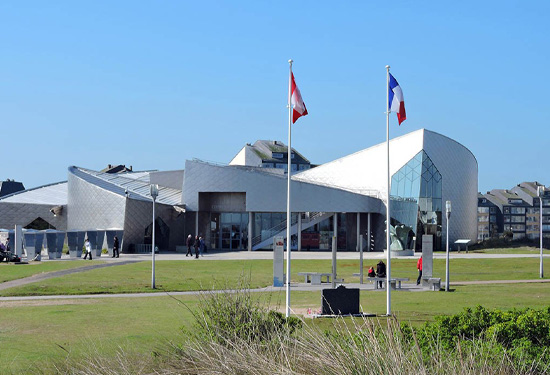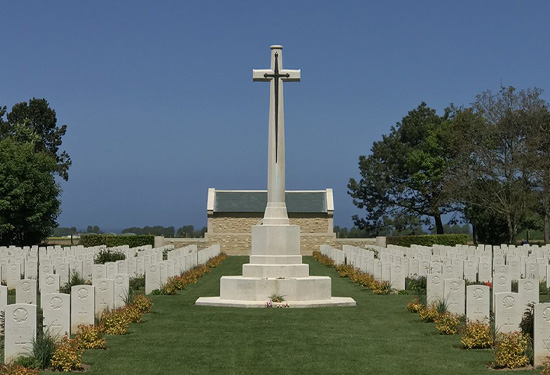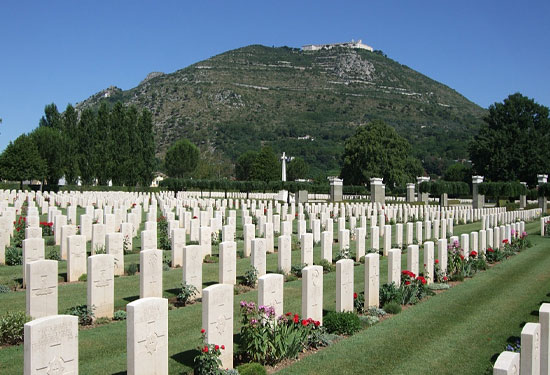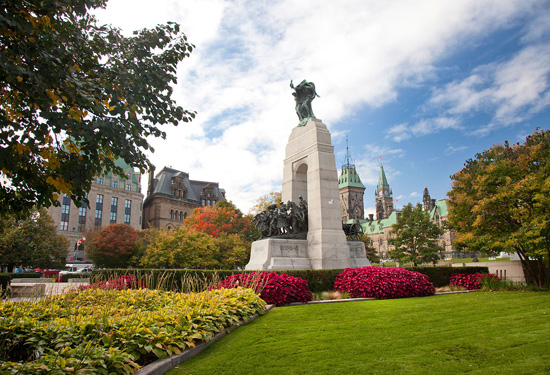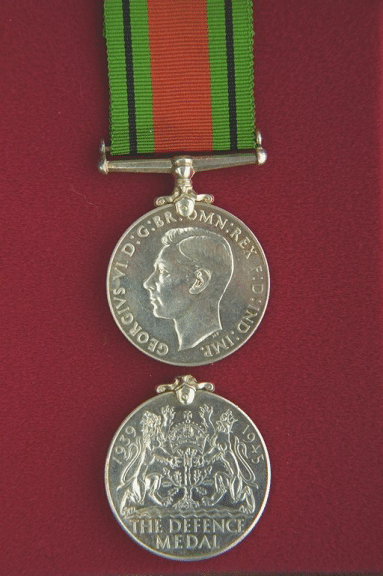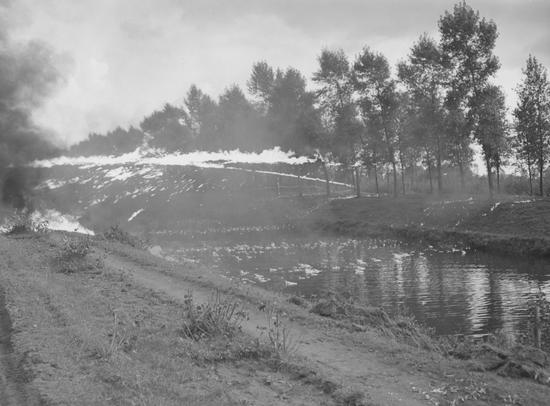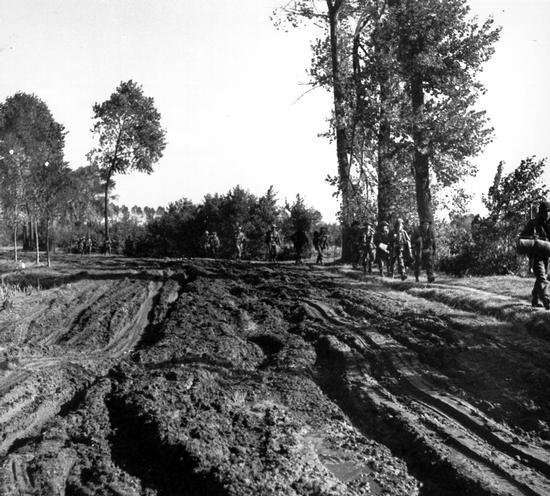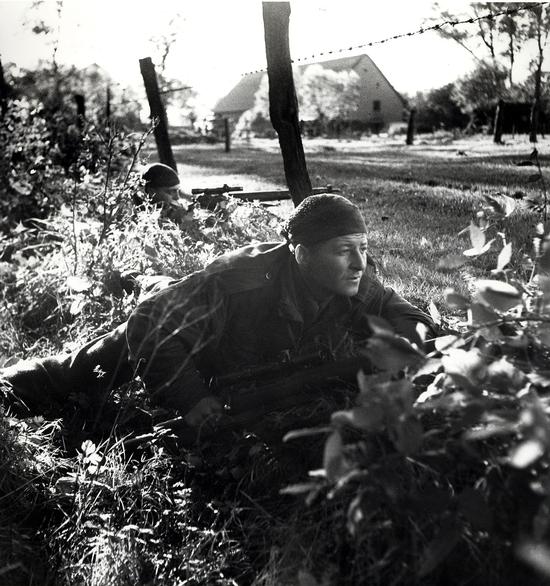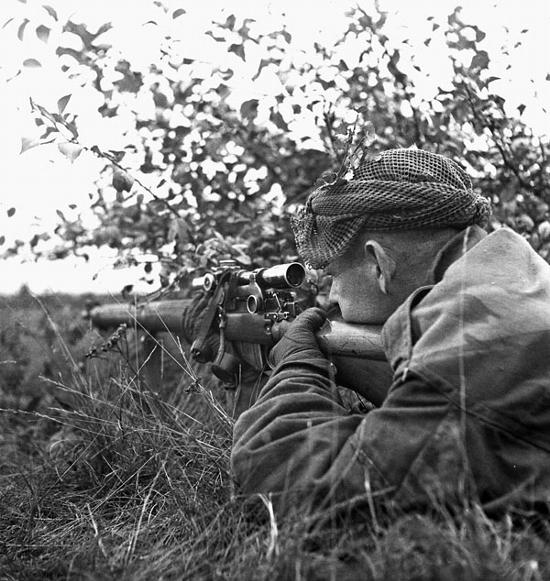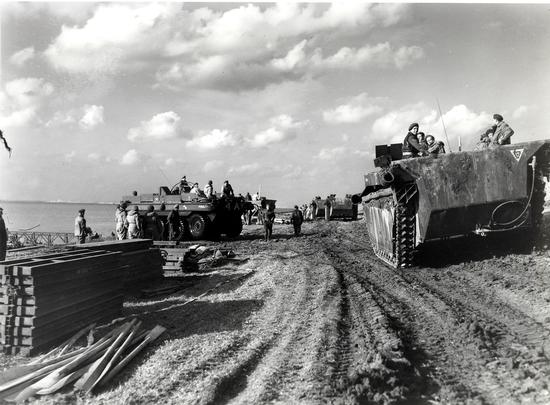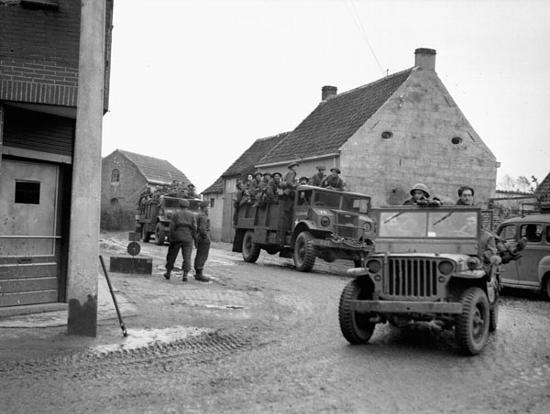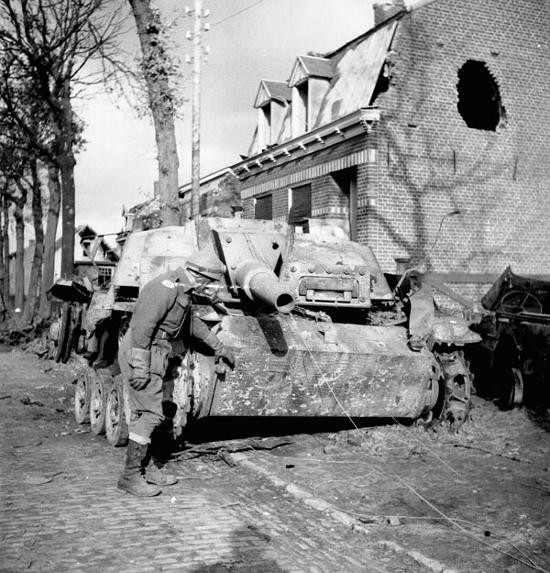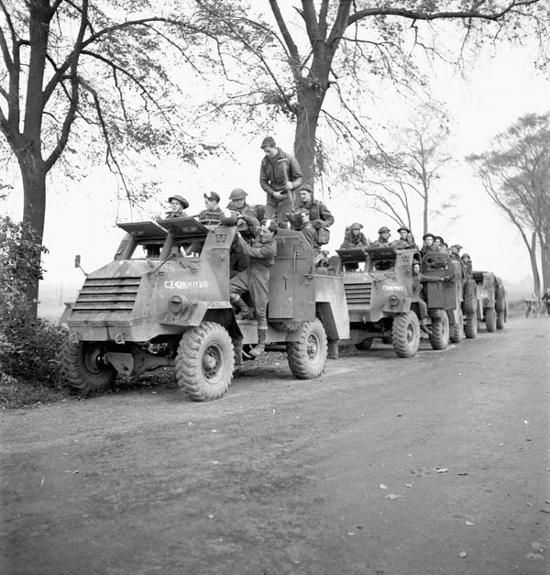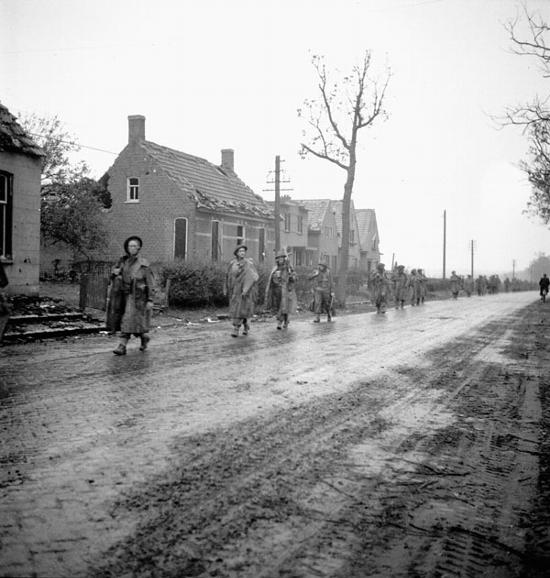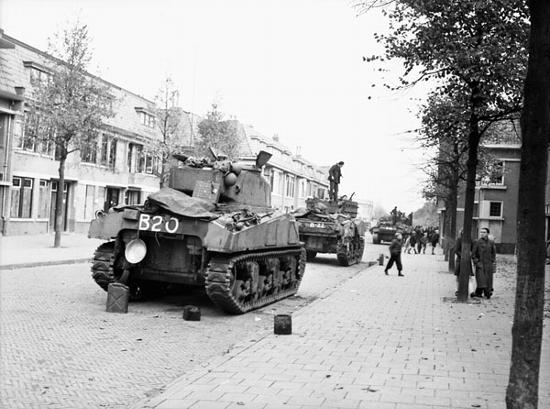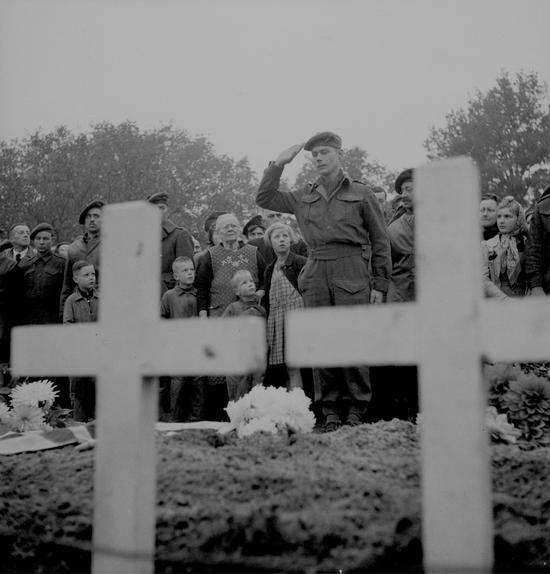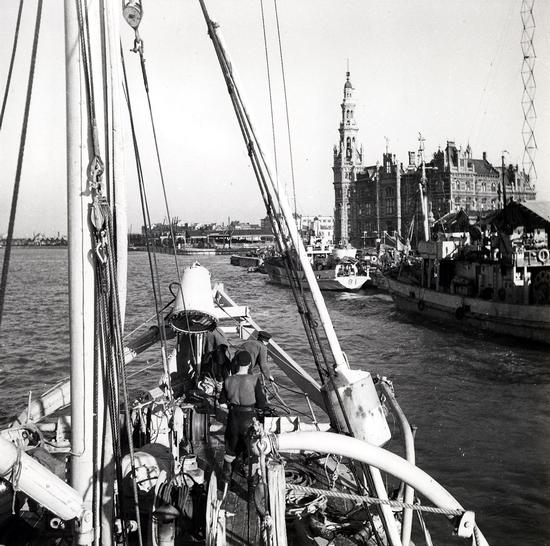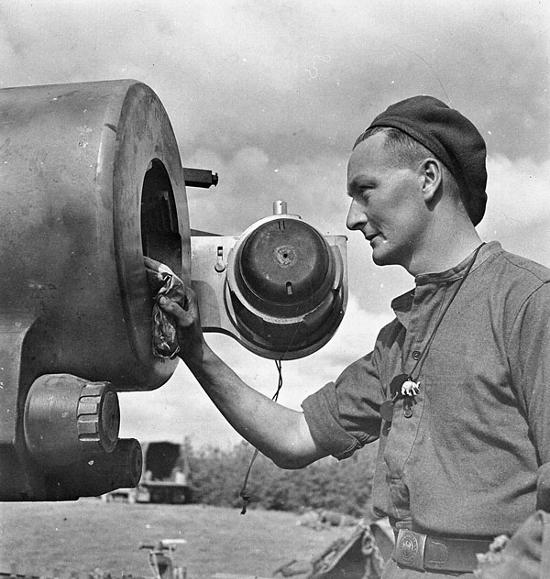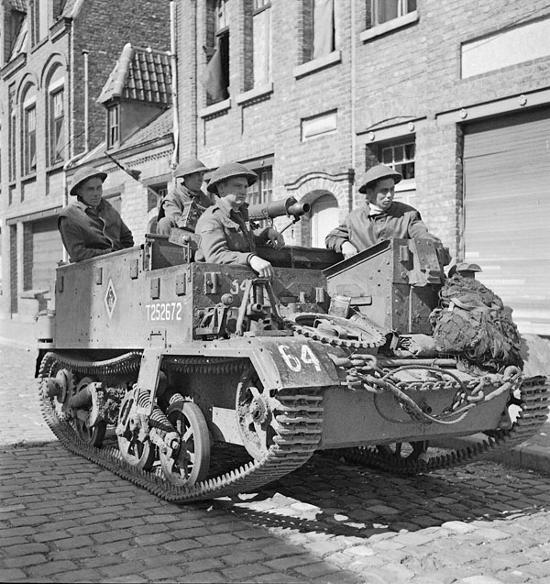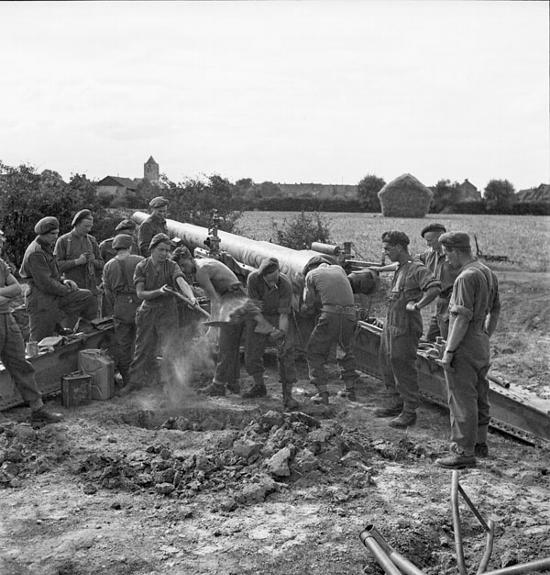
Liberation of Belgium
In the fall of 1944, Canadian troops helped liberate Belgium in northwest Europe.
2 September 1944 – 4 February 1945
Second World War
Table of contents
Section 1
Section 2
Section 3
- A clear opportunity
- Clearing the Breskens Pocket: Operation "Switchback"
- Intentional flooding helps the enemy
- Dry ground assault
- A two-pronged assault
- Amphibious maneuvers
- The clearing of South Beveland: Operation "Vitality"
- Capture of Walcheren Island
- The fall of Middelberg
- Victory in the Scheldt
- Air and sea support
- Remembering their sacrifice
- Second World War battles
Classroom materials
Introduction
During the Second World War, Belgium was the scene of major fighting by the First Canadian Army from September to November 1944. The Canadians were given the important tasks of clearing coastal areas in the north of France and capturing the launching sites of German rockets to put an end to their attacks on southern England. The First Canadian Army also played a leading role in opening the Scheldt estuary (tidal river), gateway to the Belgian port of Antwerp. Access to this port was essential to maintain supply lines to the Allied armies as they continued their push toward Germany to defeat Adolf Hitler's forces and free Western Europe from four years of Nazi occupation which had begun in April 1940.

Vehicles of the 3rd Canadian Infantry Division moving through Bockhoute, Belgium. October 18, 1944 / Bockhoute, Belgium. Photo: Lieut. Donald I. Grant / Canada. Dept. of National Defence / Library and Archives Canada / PA-137188
First Canadian Army
Under the command of General Henry Duncan Graham (Harry) Crerar, the First Canadian Army was international in character. It was comprised of two Corps—the 1st British Corps and the 2nd Canadian Corps. The 2nd Canadian Corps included the 1st Polish Armoured Division as well as three Canadian Divisions—the 2nd and 3rd Canadian Infantry Divisions and the 4th Canadian Armoured Division. Belgian and Dutch units also served in the First Canadian Army in the initial advance, but were transferred to the Second British Army as it began operations in Belgium and moved on to the Netherlands. The First Canadian Army in northwestern Europe during the final phases of the war was a powerful force, the largest army that had ever been under the control of a Canadian general. The strength of this army ranged from approximately 105,000 to 175,000 Canadian soldiers to anywhere from 200,000 to over 450,000 when including the soldiers from other nations.
Canadian casualties
More than 800 Canadian soldiers died in battle in Belgium. Most died in September and October of 1944 while liberating the region of Flanders, which included the cities of Furnes, La Panne, Nieuport, Ostend, Knocke-Heist, Bruges, Eecloo, and the northern suburbs of Antwerp. In addition, more than 7,600 Canadian soldiers died during the Liberation of the Netherlands, many while helping free the Scheldt estuary and opening up the port of Antwerp for shipping.
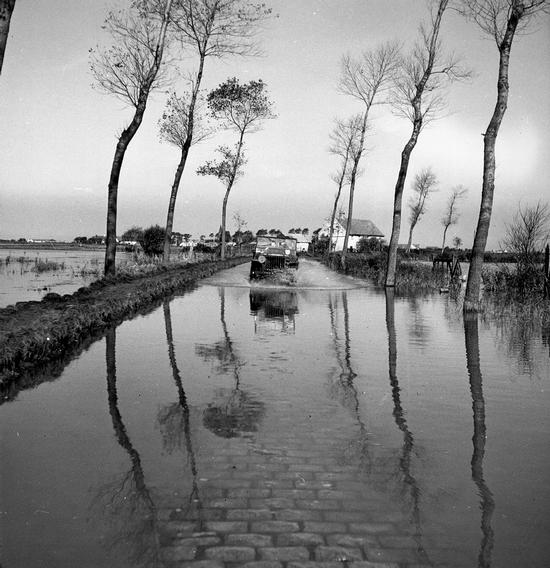
Flooded section of road near Ostend, Belgium. September 11, 1944. Photo: Donald I. Grant/Canada. Dept. of National Defence/Library and Archives Canada/PA-116728
The Road to the Scheldt
The Allied forces, including the 3rd Canadian Infantry Division and the 2nd Canadian Armoured Brigade of the First Canadian Army, landed on the beaches of Normandy, France on D-Day, June 6, 1944. As the armies progressed further inland, the First Canadian Army engaged in bitter fighting at Caen and Falaise. Once the Battle of Normandy was won on August 25, 1944, the First Canadian Army was assigned the task of clearing the coastal areas and opening the English Channel ports for supplies vital to the Allied advance.
Fighting on the left flank of the Allied forces, the First Canadian Army pushed rapidly eastward through France toward Belgium. September began with the 2nd Canadian Division being welcomed to Dieppe. The 2nd Canadian Corps left a number of units to guard the heavily defended ports and pushed toward Belgium.
Pushing to Roulers
To the south of the Canadians, the 1st British Corps entered the city of Le Havre on September 3. In the meantime, the troops of the 1st Polish Armoured Division crossed the Somme and led the 2nd Canadian Corps as they drove northward. On September 5, the 4th Canadian Armoured Division took St. Omer and on the 6th crossed the Franco-Belgian border and overcame enemy forces at Ypres and Passchendaele (sites of well-known First World War Canadian battles). On September 7 they reached Roulers, Belgium.
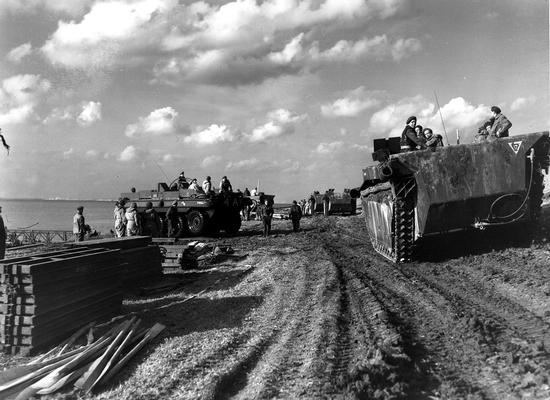
'Alligator' and 'Terrapin' amphibious vehicles parked along the Scheldt River near Terneuzen, the Netherlands. 13 October 1944. Photo: Library and Archives Canada/PA-114754
Allies take Antwerp
The Second British Army, meanwhile, was speeding through Brussels on its way to Antwerp, which it seized on September 4 with its installations virtually intact, an important first step to opening this major seaport to Allied shipping.
On September 9, and again on the night of September 10 to 11, the 1st Polish Armoured Division attempted to create a crossing of the Ghent Canal halfway between Bruges and Ghent. The Poles encountered heavy German opposition over the difficult terrain, and were forced to abandon the attack. They then moved north to relieve the 7th British Armoured Division in the Ghent area.
Battle at the Ghent Canal
Meanwhile, the 4th Canadian Armoured Division had resumed its advance on September 6 moving forward toward the Belgian towns of Bruges and Eecloo. On September 8, the Canadians arrived at the Ghent Canal. The Germans had destroyed all bridges in an attempt to slow the Allied advance towards Antwerp and the Scheldt.
On the evening of September 8, an attack was launched across the canal near Moerbrugge, five kilometres south of Bruges. Enemy mortar and heavy fire came down, but a narrow bridgehead was established, and by September 10 a bridge had been built across the Ghent Canal to give support. The bridgehead was gradually extended, but the difficult terrain and enemy resistance slowed further progress.

Buffalo amphibious vehicles taking troops across the Scheldt in Holland. (Library and Archives Canada PA-41505)
Clearing the coast
The 2nd Canadian Infantry Division received a tumultuous welcome to Dieppe, where Canadian forces had suffered very high casualties in a failed attempt to storm the beaches in 1942 (out of 4,963 Canadians who took part in the raid, 907 were killed and 1,946 taken prisoner). On September 6, they marched eastward with the objective of clearing the entire coastal area east of Calais, including the heavily fortified port of Dunkirk, capturing the launching sites of German rockets and putting an end to their attacks on southern England.
Bourbourg through Mardick
On September 7 and 8, the 2nd Canadian Infantry Division's 5th Brigade captured Bourbourg, southwest of Dunkirk, and then worked to contain the Dunkirk garrison. The Germans had an estimated 10,000 troops in Dunkirk, with outposts in the villages of Mardick, Loon-Plage, Spyker, Bergues and Bray Dunes. Loon-Plage and nearby Coppenaxfort were liberated on September 9; Mardick was taken on September 17.

Canadians enter Bergen-op-Zoom. (Library and Archives Canada PA-113666)
Belgian White Brigade assists
East of Dunkirk, in the area of the Franco-Belgian border, the 2nd Canadian Infantry Division's 6th Brigade occupied Furnes, Nieuport and La Panne. The Canadians received great assistance from the Belgian White Brigade, Belgium's national resistance movement, which furnished exact information concerning the enemy's strength, defences and minefields. West of La Panne, the 6th Brigade cleared the area of Bray Dunes as well as the nearby village of Ghyvelde.
On September 9, the 2nd Canadian Infantry Division's 4th Brigade moved north to occupy the Belgian port of Ostend. This port, although fortified, was not defended by the Germans. The harbour installations, however, had been partly demolished which delayed its opening. Still, on September 28, stores and bulk petrol began flowing through Ostend which provided much-needed supplies to the Allied front.
Bruges
The 2nd Canadian Infantry Division's 4th Brigade then moved to the southern outskirts of Bruges to assist the 4th Canadian Armoured Division in that sector. Fortunately, the enemy withdrew without contesting possession of the city, and the Canadians entered the city to an enthusiastic welcome from the Belgian people. The 4th Brigade then turned back and attacked Bergues, a key part of Dunkirk's outer defences, which fell on September 16.
Despite being surrounded, the main German force in Dunkirk showed no sign of surrendering, and the port could only have been taken by a major attack with heavy support. Instead, the Allies simply contained the port with minimum forces and concentrated every available resource on opening Antwerp. This freed the 2nd Canadian Infantry Division to move to the Scheldt area at once.

Soldier of the Royal Regiment of Canada rests in Blankenberge, September 1944. (Library and Archives Canada PA-116730)
Germans hold channel ports at all costs
The Germans were determined to hold the Channel ports at all costs. These had been heavily fortified and the German defenders had resolved not to surrender. The distance between these ports and the Allied front meant that supply routes became stretched and Allied commanders worried that their advance might be slowed or, worse, halted completely.
Le Havre, Boulogne and Calais were taken by the 3rd Canadian Infantry Division only after massive attacks with combined air and ground assaults. Because of these attacks, the port installations were largely destroyed and would require months of repair before they could be made operational for Allied shipping. On October 1, the only harbours north of the Seine receiving Allied shipping were Dieppe, its subsidiary Le Tréport, and Ostend.
The Netherlands
Meanwhile, the Second British Army had pushed forward into the southern Netherlands. On September 17, three British and American airborne divisions, as well as a brigade of Polish parachute troops, attempted to land behind enemy lines at Nijmegen, Eindhoven and Arnhem. Code-named Operation Market Garden, the mission's objective was to seize a bridge over the Rhine River at Arnhem. The operation failed, with 1,400 of the original force of 35,000 killed and more than 6,000 taken prisoner. Any hope for a speedy end to the war appeared to be dashed.

International halftrack crossing Albert Canal, September 1944. (Library and Archives Canada PA-114574)
Port of Antwerp
For the Allies, securing adequate supply lines for the winter now became paramount. The Second British Army had seized the port of Antwerp with its installations virtually intact. As Europe's second-largest port, Antwerp and its 45 kilometres of docks was an ideal landing ground for supplies for the continuing war effort. In fact, the opening of the port of Antwerp was essential, since at this point the main supply lines still ran back to Normandy.
However, German occupiers still controlled the Scheldt river which connected the port of Antwerp to the North Sea. As long as the Germans held control of the sea approaches and the long winding estuary, Allied shipping to the port would be impossible. The mere occupation of Antwerp was not enough—all the lands surrounding the Scheldt would have to be liberated first.
The Battle of the Scheldt
The task of liberating the Scheldt was entrusted to the First Canadian Army, under the command of Lieutenant-General Guy Simonds (in place of General Crerar, who had returned to England because of severe illness).
The unique geography of the area made the First Canadian Army's challenge even more daunting. North of the estuary lay South Beveland. Beyond South Beveland lay the island of Walcheren, which had been fortified into a powerful German stronghold. The south bank of the estuary was flat floodlands enclosed by dykes, known as "polder country." It was below sea level and well-suited to defence.

Road flooded by German forces near Furnes, September 1944. (Library and Archives Canada PA-131227)
Breskens Pocket
On September 21, the First Canadian Army's armoured divisions moved northward roughly along the line of the Ghent-Terneuzen Canal. The 4th Canadian Armoured Division was given the task of clearing the Breskens pocket (an area on the south shore of the Scheldt around the Dutch town of Breskens), while the 1st Polish Armoured Division headed for the Dutch-Belgian border further east and the crucial area north of Antwerp.
Attack at Moerkerke
The 4th Canadian Armoured Division had advanced from a hard-won bridgehead over the Ghent Canal at Moerbrugge to find themselves the first Allied troops to face the formidable obstacle of the double line of the Leopold and Dérivation de la Lys Canals. An attack was mounted in the vicinity of Moerkerke. The canals were crossed and a bridgehead established, but fierce counter-attacks by the enemy forced them to withdraw with heavy casualties.

Member of Canadian Provost Corps talking to members of the Belgian Resistance, Bruges, September 1944. (Library and Archives Canada PA-116733)
South bank of the Scheldt secured
Further east, the 1st Polish Armoured Division enjoyed greater success as it moved up from Ghent heading northeast. In country unsuitable for armour, and against stiffening resistance, the Division managed to smash its way to the coast by September 20. This allowed them to occupy Terneuzen and clear the south bank of the Scheldt eastward to Antwerp.
But these achievements also clarified the situation facing the First Canadian Army. Any further ground captured from the Germans in the Scheldt would only be made at heavy cost. It was also evident that the Breskens pocket was strongly and fiercely held by the enemy. It extended all the way along the coast from Zeebrugge to the Braakman Inlet and inland to the Leopold Canal.
Opening the Scheldt Estuary
The plan for opening the estuary involved four main operations. The first was to clear the area north of Antwerp and secure access to South Beveland. The second was to clear the Breskens pocket north of the Leopold Canal (Operation Switchback). The third, Operation Vitality, was the capture of South Beveland. The final phase would be the capture of Walcheren Island.

Royal Canadian Engineers lowering pipe into roadway excavation, Ostend, October 1944. (Library and Archives Canada PA-130263)
Fighting North from Antwerp
On October 2, the 2nd Canadian Infantry Division began its advance north from Antwerp to reach South Beveland and then advance into it. Initial progress was made, despite stiff opposition. By October 6, with the town of Woensdrecht less than five kilometres away, the objective of the first phase seemed within grasp. The Germans, however, were determined to hold Woensdrecht, which controlled direct access to South Beveland and Walcheren Island.
There were heavy casualties as the Canadians attacked over open, flooded land. Driving rain, booby traps and landmines made advance very difficult. October 13, on what would come to be known as Black Friday, saw the Canadian 5th Infantry Brigade's Black Watch battalion virtually wiped out in heavy fighting.
Attack on Woensdrecht
Finally, on October 16, the final attack on Woensdrecht was launched, with the support of an immense artillery barrage. As the Allied artillery brought down a heavy concentration of fire within metres of their own troops, the Germans fell back. Woensdrecht was secure and South Beveland and Walcheren were cut off from the mainland. The Canadians had achieved their first objective, but suffered heavy casualties.

Scouts of Calgary Highlanders advancing north of Kappellen, October 1944. (Library and Archives Canada PA-116727)
A clear opportunity
At this point, the challenge and opportunity was clear to all, and Field-Marshal Bernard Montgomery, overall commander of the First Canadian Army and the Second British Army, issued a directive that made the opening of the Scheldt estuary the top priority. To the east, the British Second Army attacked westward to clear the Netherlands south of the Maas River. This helped secure the Scheldt region from an outside counter-attack.
Meanwhile, Lieutenant-General Simonds concentrated on the area north of South Beveland. The 4th Canadian Armoured Division, which had been engaged at the Leopold Canal, moved north of the Scheldt and drove hard for the town of Bergen-op-Zoom. By October 24, access to South Beveland was sealed off.
Clearing the Breskens Pocket: Operation "Switchback"
The second main operation of the Battle of the Scheldt opened with fierce fighting along the Scheldt's southern shore in what was called the Breskens pocket. Here, the 3rd Canadian Infantry Division encountered tenacious German resistance as they fought to cross the Leopold Canal and clear the Breskens pocket.

Scheldt Embarkation Point, West of Terneuzen, October 1944. (Library and Archives Canada PA-168670)
Intentional flooding helps the enemy
An earlier failed attempt by the 4th Canadian Armoured Division at Moerbrugge had demonstrated the challenge they faced. In addition to the formidable German defences on both the Leopold Canal and the Dérivation de la Lys Canal, much of the approach area was flooded. Furthermore, the flooded terrain concealed the enemy from the infantry, thus making aerial reconnaissance of enemy positions an absolute necessity. As a result, there were few areas where a determined assault had much hope of success.
Dry ground assault
It was decided that the best place for an assault would be immediately east of where the two canals divided. This was a narrow strip of dry ground beyond the Leopold Canal—a long triangle with its base on the Maldegem-Aardenburg road and its apex near the village of Moershoofd some five kilometres east. It was only a few hundred metres wide, even at its base, and its northern boundary coincided with the border between Belgium and the Netherlands.

Village of Biervliet in the Breskens Pocket, October 1944. (Library and Archives Canada PA-131251)
A two-pronged assault
A two-pronged assault commenced. The 3rd Canadian Infantry Division's 7th Brigade made the initial assault across the Leopold Canal, while the 9th Brigade mounted an amphibious attack from the northern or coastal side of the pocket. The assault began on October 6, supported by extensive artillery and "Wasps" (tanks equipped with flamethrowers). The Wasps launched their barrage of flame across the Leopold Canal, allowing the 7th Brigade troops to scramble up over the steep banks and launch their assault boats across the canal. Two precarious, separate footholds were established, but conditions for the Canadian troops were horrendous as the enemy recovered from the shock of the flamethrowers and counter-attacked. However, the troops clung with grim determination to their extremely vulnerable bridgeheads. By October 9, the gap between the bridgeheads was closed, and by early morning on October 12, a position had been gained across the Aardenburg road.
Amphibious maneuvers
The 3rd Canadian Infantry Division's 9th Brigade conducted an amphibious operation with the aid of "Terrapins" and "Buffaloes"—amphibious vehicles manned by the British 5th Assault Regiment Royal Engineers. The brigade planned to cross the mouth of the Braakman Inlet in amphibious vehicles and to land in the vicinity of Hoofdplaat, a tiny hamlet in the rear or coastal side of the pocket, thus exerting pressure on the enemy from two directions at once. In spite of difficulties in maneuvering vehicles through the canals and the resulting 24-hour delay, the enemy was taken by surprise and a bridgehead was established. Once again the enemy recovered quickly and counter-attacked with ferocity, however, they were slowly forced back. The 10th Brigade of the 4th Canadian Armoured Division crossed the Leopold Canal and advanced at Isabella Polder. Then the 3rd Canadian Infantry Division's 8th Brigade was called to move southward from the coastal side of the pocket. This opened up a land-based supply route into the pocket.
Despite these triumphs, the 3rd Canadian Infantry Division still had to fight to free the towns of Breskens, Fort Frederik Hendrik, Oostburg, Zuidzande and Cadzand. With the Breskens pocket finally cleared, Operation Switchback ended on November 3 when the First Canadian Army victoriously liberated the Belgian towns of Knocke and Zeebrugge.

Canadian soldiers firing from Scheldt River on German positions north of Antwerp, October 1944. (Library and Archives Canada PA-131239)
The clearing of South Beveland: Operation "Vitality"
The third major operation of the battle opened on October 24 when the 2nd Canadian Infantry Division began its bridgeheads against South Beveland. The Canadians hoped to advance rapidly, by-passing opposition and seizing operations over the Beveland Canal, but they too were slowed by mines, mud and strong enemy defences.
An amphibious attack was made across the West Scheldt by the 52nd (Lowland) Division to get in behind the German's Beveland Canal defensive positions. Thus, this formidable defence was outflanked, and the 6th Canadian Infantry Brigade began a frontal attack in assault boats. The engineers were able to bridge the canal on the main road. With the canal line gone, the German defence crumbled and South Beveland was cleared. The third phase of the Battle of the Scheldt was now complete.
Capture of Walcheren Island
As the fourth phase of the battle opened, only the island of Walcheren at the mouth of the West Scheldt remained in enemy hands. The island's defences were extremely strong and the only land approach was the long narrow causeway from South Beveland. To make matters worse, the flats that surrounded this causeway were too saturated with sea water for movement on foot, but had too little water for an assault in storm boats.
The island was attacked from three directions: across the causeway from the east, across the Scheldt from the south, and by sea from the west. To hamper German defence, the island's dykes were breached by heavy Royal Air Force bombing, which flooded the central area but allowed the use of amphibious vehicles.

Royal Hamilton Light Infantry carriers move through the Dutch village of Krabbendijke on the Beveland Causeway, 27 October 1944. (Library and Archives Canada PA-205125)
The fall of Middelberg
The 2nd Canadian Infantry Division attacked the causeway on October 31 and, after a grim struggle, established a precarious foothold. Then, in conjunction with the waterborne attacks, the 52nd British Division continued the advance. On November 6, the island's capital Middelburg fell, and by November 8 all resistance ended.
Meanwhile, the 4th Canadian Armoured Division had pushed eastward past Bergen-op-Zoom to St. Philipsland where it sank several German vessels in Zijpe harbour.
Victory in the Scheldt
Thus, with the approaches to Antwerp free and the area up to the Maas River cleared, the fourth phase of the Battle of the Scheldt was complete. Victory had been achieved. The Scheldt was then laboriously cleared of mines, and on November 28, the first convoy entered the port of Antwerp, led by the Canadian-built freighter Fort Cataraqui.

Canadian troops preparing to leave Ghent, November 1944. (Library and Archives Canada PA-116741)
Air and sea support
The campaign in Northwest Europe took eleven months and could not have succeeded without the support of Allied naval and air forces. The navies kept open the sea lanes for munitions, supplies and reinforcements, while overhead the air forces cleared the skies, and engaged in dangerous bombing missions.
Remembering their sacrifice
Those Canadians who fought in Belgium achieved and sacrificed much in their efforts to help bring peace and freedom to the people of Europe. These combatants were among the more than one million men and women who served in Canada's Armed Forces during the Second World War. More than 42,000 Canadians gave their lives in the war. Canada and the world recognize the sacrifices and achievements of all the Canadians, like those who fought in Belgium, who accomplished so much and left a lasting legacy of peace.
Most of the Canadians who gave their lives in the Allied effort to liberate Belgium are buried in the following military cemeteries.
| Cemetery | Number of Burials | |
|---|---|---|
| Canadian | Total | |
| Adegem Canadian War Cemetery | 848 | 1109 |
| Brussels Town Cemetery | 74 | 588 |
| Heverlee War Cemetery, Louvain | 157 | 1001 |
| Hotton War Cemetery | 88 | 663 |
| Schoonselhof Cemetery, Antwerp | 348 | 1556 |

- Date modified:













